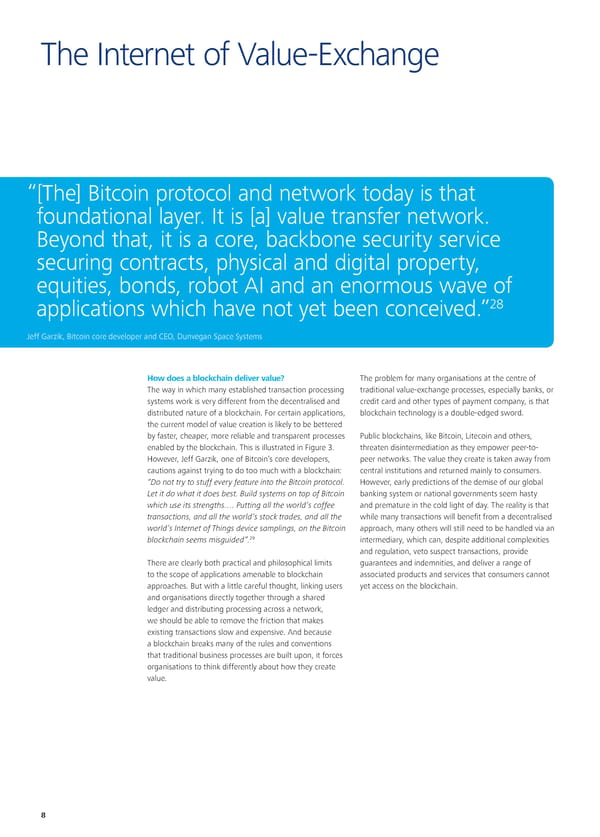To start a new section, hold down the apple+shift keys and click to release this object and type the section title in the box below. The Internet of Value-Exchange “ [The] Bitcoin protocol and network today is that foundational layer. It is [a] value transfer network. Beyond that, it is a core, backbone security service securing contracts, physical and digital property, equities, bonds, robot AI and an enormous wave of 28 applications which have not yet been conceived.” Jeff Garzik, Bitcoin core developer and CEO, Dunvegan Space Systems How does a blockchain deliver value? The problem for many organisations at the centre of The way in which many established transaction processing traditional value-exchange processes, especially banks, or systems work is very different from the decentralised and credit card and other types of payment company, is that distributed nature of a blockchain. For certain applications, blockchain technology is a double-edged sword. the current model of value creation is likely to be bettered by faster, cheaper, more reliable and transparent processes Public blockchains, like Bitcoin, Litecoin and others, enabled by the blockchain. This is illustrated in Figure 3. threaten disintermediation as they empower peer-to- However, Jeff Garzik, one of Bitcoin’s core developers, peer networks. The value they create is taken away from cautions against trying to do too much with a blockchain: central institutions and returned mainly to consumers. “Do not try to stuff every feature into the Bitcoin protocol. However, early predictions of the demise of our global Let it do what it does best. Build systems on top of Bitcoin banking system or national governments seem hasty which use its strengths…. Putting all the world’s coffee and premature in the cold light of day. The reality is that transactions, and all the world’s stock trades, and all the while many transactions will benefit from a decentralised world’s Internet of Things device samplings, on the Bitcoin approach, many others will still need to be handled via an 29 blockchain seems misguided”. intermediary, which can, despite additional complexities and regulation, veto suspect transactions, provide There are clearly both practical and philosophical limits guarantees and indemnities, and deliver a range of to the scope of applications amenable to blockchain associated products and services that consumers cannot approaches. But with a little careful thought, linking users yet access on the blockchain. and organisations directly together through a shared ledger and distributing processing across a network, we should be able to remove the friction that makes existing transactions slow and expensive. And because a blockchain breaks many of the rules and conventions that traditional business processes are built upon, it forces organisations to think differently about how they create value. 8
 Blockchains: Enigma. Paradox. Opportunity. Page 9 Page 11
Blockchains: Enigma. Paradox. Opportunity. Page 9 Page 11